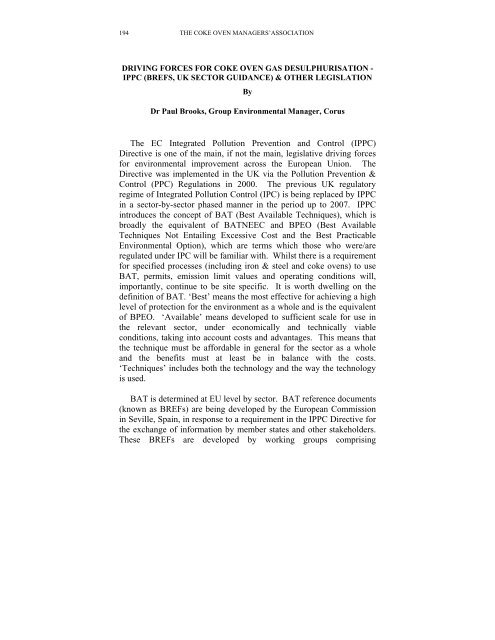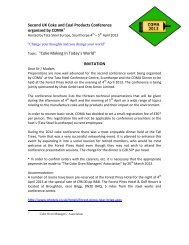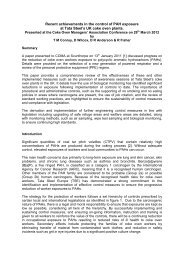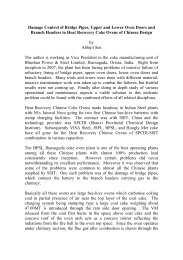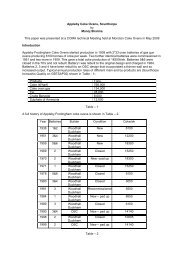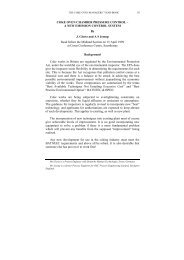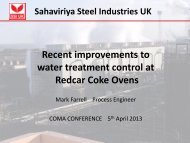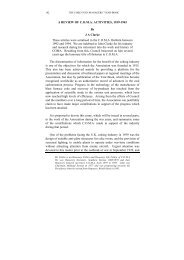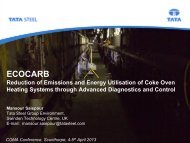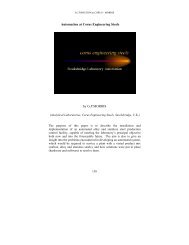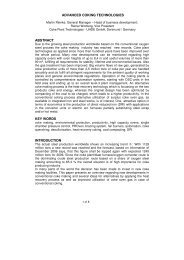The EC Integrated Pollution Prevention and Control (IPPC) Directive ...
The EC Integrated Pollution Prevention and Control (IPPC) Directive ...
The EC Integrated Pollution Prevention and Control (IPPC) Directive ...
Create successful ePaper yourself
Turn your PDF publications into a flip-book with our unique Google optimized e-Paper software.
194THE COKE OVEN MANAGERS’ASSOCIATIONDRIVING FORCES FOR COKE OVEN GAS DESULPHURISATION -<strong>IPPC</strong> (BREFS, UK S<strong>EC</strong>TOR GUIDANCE) & OTHER LEGISLATIONByDr Paul Brooks, Group Environmental Manager, Corus<strong>The</strong> <strong>EC</strong> <strong>Integrated</strong> <strong>Pollution</strong> <strong>Prevention</strong> <strong>and</strong> <strong>Control</strong> (<strong>IPPC</strong>)<strong>Directive</strong> is one of the main, if not the main, legislative driving forcesfor environmental improvement across the European Union. <strong>The</strong><strong>Directive</strong> was implemented in the UK via the <strong>Pollution</strong> <strong>Prevention</strong> &<strong>Control</strong> (PPC) Regulations in 2000. <strong>The</strong> previous UK regulatoryregime of <strong>Integrated</strong> <strong>Pollution</strong> <strong>Control</strong> (IPC) is being replaced by <strong>IPPC</strong>in a sector-by-sector phased manner in the period up to 2007. <strong>IPPC</strong>introduces the concept of BAT (Best Available Techniques), which isbroadly the equivalent of BATNE<strong>EC</strong> <strong>and</strong> BPEO (Best AvailableTechniques Not Entailing Excessive Cost <strong>and</strong> the Best PracticableEnvironmental Option), which are terms which those who were/areregulated under IPC will be familiar with. Whilst there is a requirementfor specified processes (including iron & steel <strong>and</strong> coke ovens) to useBAT, permits, emission limit values <strong>and</strong> operating conditions will,importantly, continue to be site specific. It is worth dwelling on thedefinition of BAT. ‘Best’ means the most effective for achieving a highlevel of protection for the environment as a whole <strong>and</strong> is the equivalentof BPEO. ‘Available’ means developed to sufficient scale for use inthe relevant sector, under economically <strong>and</strong> technically viableconditions, taking into account costs <strong>and</strong> advantages. This means thatthe technique must be affordable in general for the sector as a whole<strong>and</strong> the benefits must at least be in balance with the costs.‘Techniques’ includes both the technology <strong>and</strong> the way the technologyis used.BAT is determined at EU level by sector. BAT reference documents(known as BREFs) are being developed by the European Commissionin Seville, Spain, in response to a requirement in the <strong>IPPC</strong> <strong>Directive</strong> forthe exchange of information by member states <strong>and</strong> other stakeholders.<strong>The</strong>se BREFs are developed by working groups comprising
DRIVING FORCES FOR COKE OVEN GAS DESULPHURISATION - <strong>IPPC</strong>(BREFS, UK S<strong>EC</strong>TOR GUIDANCE) & OTHER LEGISLATION195representatives from member states, industry, environmental NGOs(non-governmental organisations) <strong>and</strong> to a lesser extent equipmentsuppliers. It is important to note, however, that whilst the BREFs are auseful source of information, they have no legal status except asguidance to be taken into account by member states when determiningpermits at the local level. Whilst achievable emission levels are quoted,these are not emission limit values <strong>and</strong> are not absolute st<strong>and</strong>ards to beenforced.<strong>The</strong> iron <strong>and</strong> steel BREF, which includes coke making, waspublished in March 2000 <strong>and</strong> is due for revision in 2004/2005.Desulphurisation of coke oven gas was considered a high priority bythe BREF technical working group <strong>and</strong>, therefore, was defined as BATat a sector level for minimising SO 2 releases from coke making for bothnew <strong>and</strong> existing plants. Importantly, no particular techniques wereidentified as BAT as there are advantages <strong>and</strong> disadvantages for eachprocess, which have to be considered in the context of the localsituation.Process options can be generally divided into either wet oxidationprocesses (e.g. Stretford) or absorption processes (e.g. Still orSulfiban). <strong>The</strong>re are numerous reference plants around the worldincluding Dofasco (Stretford), Coke Plant 2 Corus IJmuiden (Still) <strong>and</strong>Coke Plant 1 Corus IJmuiden (Sulfiban).In the UK, the Environment Agency has produced guidance for thecoke, iron <strong>and</strong> steel sector, although this is still in draft form, nearlytwo years after being issued for consultation. Whilst this guidance setsindicative st<strong>and</strong>ards which should be met unless there is justificationfor not doing so, it should be noted that BAT is, in fact, site specific<strong>and</strong> EA sector guidance is exactly that, i.e. guidance, not a series ofprescriptive requirements. <strong>The</strong> expectation of the Environment Agencyis, however, that operators who do not have coke oven gasdesulphurisation should install it by 2007.Irrespective of this though, BAT has to be determined locally, takinginto account for example local air quality <strong>and</strong> other factors. In thiscontext, SO 2 is less of an issue in South Wales, due to low background
196 THE COKE OVEN MANAGERS’ASSOCIATIONlevels, but more of an issue in Scunthorpe where the Trent Valley <strong>and</strong>other power stations have a significant influence. On Teesside there isalso a specific short-term problem, although this should be addressedby means other than coke oven gas desulphurisation.Whilst <strong>IPPC</strong> is an important legislative driver, other legislation willalso have an impact. <strong>The</strong> National Emissions Ceiling <strong>Directive</strong> placesabsolute limits on member states for a number of emissions, includingSO 2. <strong>The</strong> impact of this on the iron, steel <strong>and</strong> coke making industrydepends on how the directive is implemented in the UK, e.g. by burdensharing across all sectors or by lowest cost options. It will also becomplicated by related legislation such as the Large Combustion Plant<strong>Directive</strong>, which again depending on how it is implemented, couldintroduce very strict limits on SO 2 emissions from power plants(effectively requiring coke oven gas desulphurisation if coke oven gasis one of the fuels used in the power plant). <strong>The</strong> EU Emissions Trading<strong>Directive</strong> will also have an impact <strong>and</strong> through market forces, couldchange the way we look at emissions reductions <strong>and</strong> pollution controloptions.In conclusion, coke oven gas desulphurisation is BAT atsector/BREF level <strong>and</strong> at the UK sector guidance level. However,BREFs are not prescriptive <strong>and</strong> sector guidance is only guidance. PPCis site specific <strong>and</strong> there is scope to justify that coke oven gasdesulphurisation is not BAT at local level based on cost benefitanalysis. However, there is other legislation which may require cokeoven gas desulphurisation to be installed.


